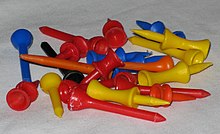Tee
A tee is a stand used to support a stationary ball so that the player can strike it, particularly in golf, Tee Ball, American football, and rugby.
Etymology
The word tee is derived from the Scottish Gaelic word tigh meaning house and is related to the 'house' in curling (the coloured circles). This would make sense, as the first golf tees were within a circle of one club length round the hole. Nowadays, modern courses have separate, designated tee boxes for each hole. For example, the ninth hole of a course is played from the ninth tee to the ninth green, and similarly for the other holes.
Golf tee

In golf, a tee is normally used for the first stroke of each hole, and the area from which this first stroke is hit is informally also known as the teeing ground. Normally, teeing the ball is allowed only on the first shot of a hole, called the tee shot, and is illegal for any other shot; however, local or seasonal rules may allow or require teeing for other shots as well, e.g., under "winter rules" to protect the turf when it is unusually vulnerable. Teeing gives a considerable advantage for drive shots, so it is normally done whenever allowed. However, a player may elect to play his/her tee shot without a tee. This typically gives the shot a lower trajectory.
A standard golf tee is 2.125" (two and one eighth inches) long, but both longer and shorter tees are permitted and are preferred by some players. Now, designs of these golf tees have a slight adjustment with the holster for the ball, better known as zero friction or more trajectory tees. These generally have a tri-holster, which some people find hard to balance the ball on. Ordinary tees can be made from wood or from durable plastic.
According to the R&A rule book, for a tee to be legal, "It must not be longer than 4 inches (101.6 mm) and it must not be designed or manufactured in such a way that it could indicate the line of play or influence the movement of the ball."[1]
History
The development of the tee was the last major change to the rules of golf. Before this, golf balls were teed up on little heaps of sand that were provided in boxes. This explains the historical name tee boxes for what is today known as teeing ground.
The earliest golf tees rested flat on the ground and had a raised portion to prop up the ball. The first patent for this kind of tee is dated 1889, and was issued to Scotsmen William Bloxsom and Arthur Douglas.[2] The first known tee to pierce the ground was a rubber-topped peg sold commercially as the "Perfectum." This was patented in 1892 by Percy Ellis of England.[2] In 1899, an African-American dentist, Dr. George Franklin Grant obtaned a patent for an "improved golf tee".[3] This tee consisted of a wood cone with a rubber sleeve to support the ball, but it is not known to have ever been marketed.
-
British patent #12941 of 1889.
-
British patent #3916 of 1892.
-
U.S. Patent #570,821, "Combined Golf Tee and Score Card," 1896.
-
British patent #253 of 1896.
-
British patent #14292 of 1897.
-
U.S. Patent #638,920, Dr. George Franklin Grant, 1899.
-
U.S. Patent 1,670,267, William Lowell, Sr. in 1925
These and other variations failed to catch on, as most golfers—whether because of tradition, habit, or concerns about the rules—continued using heaps of sand. It took a strong marketing effort by Dr. William Lowell, Sr. in the 1920s to bring manufactured tees into widespread use. Sales of his "Reddy Tee," a simple wooden peg with a flared top, took off after Lowell hired professional golfers Walter Hagen and Joe Kirkwood, Sr. to promote the product during exhibition matches. It was copied around the world, and remains the most common type of golf tee.
Tee Ball tee
Tee Ball is based on baseball, with the main difference being the use of a tee in the place of a pitcher. Much larger than a golf tee, the Tee Ball tee is a rubber stand attached to the home plate which supports the baseball at a suitable height for the batter to hit. It is adjustable to allow for variations in batter height.
Kicking tee
A kicking tee is a rubber or plastic platform, often with prongs and/or a brim around an inner depression.
In American football and its variants, a tee may be used on kickoffs to raise the ball slightly above the playing surface (up to one inch, by NFL and NCAA rules). The CFL and some high school leagues also allow the use of tees on field goal and extra point kicks, where another player (the holder) places one end of the ball on the tee (usually just a rubber block) and holds the opposite end.
Tees may also be used for place kicks in rugby league football and rugby union football.
References
- ^ "R&A Rules of Golf". Retrieved on 2008-12-19
- ^ a b Valenta, Irwin R. The Singular History of the Golf Tee, Greensboro, North Carolina, 1995. Summary at [1]
- ^ George Grant - Improved Golf Tee, Mary Bellis, inventors.about.com.







